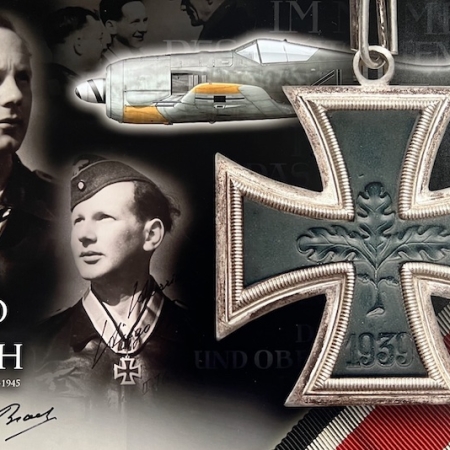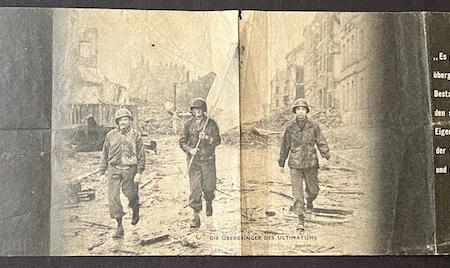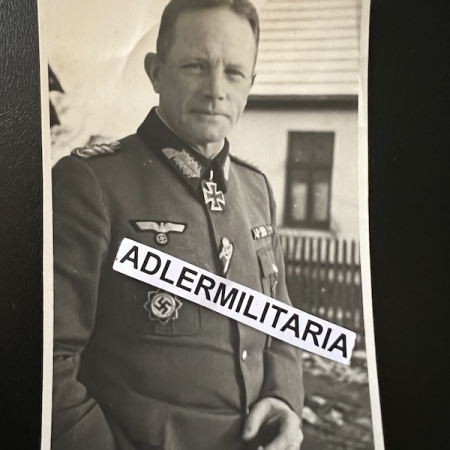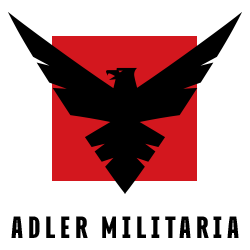Showing 226–234 of 242 resultsSorted by latest
-

Post War Signature of Knights Cross Winner Hugo Broch – JG54 – 1
$65.00Original signed A4 size very good quality paper. Price includes shipping
-

Antique Swedish M-1815 Cutlass Sword Bayonet M/1770 Cavalry Pallasch Blade – Exceptionally Rare
$895.00Wonderful Original Antique Swedish Model 1815-20 Cutlass Sword Bayonet with a Model 1770 Cavalry Pallasch Double Edged Straight Blade that Measures 25 3/4 Inches and 29 Overall; Made for the M1815-20 or M1815-38 (see more reference information below) – Forge Mark to the Ricasso, Brass Hilt Lettered at the Guard, and Wrapped Wooden Grip, Good Issued Condition as Photographed with the mechanism missing at the ring, damage to the grip, and use wear as seen; a Fantastic Addition to Any Advanced Collection of Edged Weapons of Sweden – m/1815-20 Production more than 800 production (“fältjägarstudsare”) Sword bayonet In 31/3 1820 800 and bayonets was ordered to Jämtlands fältjägare. It was decided in 1821 that Värmlands fältjägarekår should be issued “new with mounted cutlasses as bayonets”. The bayonets were received in 1822 and after being tested, they were stored in Karlstad armoury. The blade is from m/1770 cavalry palasch.
-

WWII American Propaganda – For German Soldiers – The Lessons of Aachen Battle 1945 – Rare Flugblatt – Flyer
$75.00Dropped on German positions, this particularly rare document was prepared very late war by advancing US Army into Germany. Basically, the lesson of Aachen was that they decided to fight so the city was destroyed. Stating you have the choice to surrender now, there is no middle way” This particular Allied flyer is quite rare and in good displayable condition.
-

WWII American Propaganda – For German Soldiers – Hürtgenwald 1944 – 12 Volksgrenadier Div / 47 Volksgrenadier Div – Rare
$65.00An interesting flyer, basically stating all is lost, describing both fronts and there is a chance to survive if you surrender.
-

WWII Red Army Soviet Propaganda – For German Soldier – Pass to POW – Bank Note – 23.04.1945 – Rare – Berlin 1945
$39.50A very late pass to surrender to the Red Army, made in the form of a bank note to capture attention. Very late war (23.04.1945) perhaps used during the battle for Berlin 1945.
-
Sale!

WWII American 82nd Airborne Division – Researched D-Day Normandy – Sgt. Joseph J. Siegel Light Mortar Crewman – Dog Tags – Medals – Awards – Patches
$995.00Original price was: $995.00.$855.00Current price is: $855.00.Wonderful Original WWII U.S. Army 82nd Airborne Division D-Day Normandy Grouping of Sgt. Joseph J. Siegel Light Mortar Crewman. Sergeant Joseph Siegel (b. 15 Nov 1924 – d. 28 Dec 1984) of Buffalo, New York. This collection consists of Sergeant Siegel’s Personnel Identification Discs “Dog Tags” 1944-45 on the Chain – Medals, Awards, & Patches: Good Conduct Medal with Ribbon Bar and Enamel Lapel Bar Button American Campaign Medal with Ribbon Bar Europe Africa Middle East Campaign Medal with Ribbon Bar Showing Arrowhead and Four Campaign Stars (Ardennes, Central Europe, Normandy, & Rhineland) World War Two Victory with Ribbon Bar, Sharpshooter Marksmanship Qualification with Carbine Q Bar (both Pieces Hallmarked Sterling) Combat Infantryman Badge (Sterling), War-Time 82nd Airborne Division SSI Shoulder Patch with Tab Airborne Paratrooper Glider Infantry Overseas Garrison Cap Patch (Post-War Production) – Sgt. Siegel’s Original 1946 Discharge Certificate and ‘Enlisted Record and Report of Separation Honorable Discharge’ of the Same Period Chronicling His Service During World War Two Complete with Government Embossed Seal.
-
Sale!

WWII German Photo – Generalleutnant Henze – Dzukste -Kurland 1944 – 21. Feld-Division (L)
$255.00Original price was: $255.00.$155.00Current price is: $155.00.Henze, Albert (Generalleutnant) Date of birth: August 7th, 1894 (Kirchhain/Hesse, Germany) Date of death: March 31st, 1979 (Ingolstadt/Bavaria, Germany) Nationality: German (1933-1945, Third Reich) Biography Promotions: January 27th, 1915: Gefreiter; April 21st, 1915: Unteroffizier; August 2nd, 1915: Vizefeldwebel; March 20th, 1916: Leutnant der Reserve; May 20th, 1920: Leutnant (Polizei); October 21st, 1934: Hauptmann (Reichsheer); January 1st, 1939: Major; December 1st, 1941: Oberstleutnant; April 1st, 1942: Oberst; November 9th, 1944: Generalmajor; May 1st, 1945: Generalleutnant. Ritterkreuz mit Eichenlaub Period: Second World War (1939-1945) Rank: Generalmajor (Brigadier) Unit: Kommandeur, Gruppe Henze, 21. Feld-Division (L), Luftwaffe Awarded on: January 21st, 1945 At the beginning of the battle of Courland, on the 23.12.1944, the Soviets managed to penetrate deeply into the combat area of the 21. Feld-Division (L) south of Dzukste following heavy artillery preparation. On the next day the Soviets continued their attack against the centre of the Division’s front with 6 rifle divisions and the bulk of a tank corps. Recognizing the danger of a breakthrough, Generalmajor Henze ordered a counterattack into the flank of the Soviet assault formation. This counterthrust managed to succeed with the support of Sturmgeschütze, and a new defensive line was formed. Soviet losses amounted to 90 tanks, 3 assault guns and 5 artillery pieces. Henze would receive the Oakleaves for this action. 709th Award.
-

WWII German Photograph – General Leo Geyr von Schweppenburg – Normandy 1944 – Wearing British Dust Glasses – Super Rare Photo
$265.00An amazing photograph, displaying him with dust glasses taken from the British Army. Geyr von Schweppenburg (2 March 1886 – 27 January 1974) was a German general during World War II who is noted for his pioneering stance and expertise in the field of armoured warfare.[2][3] He commanded the 5th Panzer Army (formalised as Panzer Group West) during the Invasion of Normandy, and later served as Inspector General of Armoured Troops. After the war, he was involved in the development of the newly-built German Army (Bundeswehr). Freiherr von Geyr was born in 1886 in Potsdam into the Prussian military aristocracy and descended from a family that had produced two Prussian field marshalls.[4] He joined the German Army in 1904. In World War I, he fought on several fronts and rose to the rank of captain. After the war, he remained in the army, becoming an Oberst in 1932 and a Generalmajor in 1935. From 1933 to 1937, he was a military attaché to the United Kingdom, Belgium and the Netherlands and resided in London. Promoted to Generalleutnant upon his return from London, he took command of the 3rd Panzer (armoured) Division in 1937.[5] World War II From 1 September to 7 October 1939, Geyr commanded the 3rd Panzer Division during the invasion of Poland, where it was the most numerically powerful Panzer Division, with 391 tanks.[6] For a victory at Kulm, he was praised on the battlefield by Hitler, who had visited the division in recognition for its achievements in Poland.[7] He was promoted to General der Kavallerie of the XXIV Panzer Corps on 15 February 1940. In 1940, he commanded the XXIV Panzer Corps in the Invasion of France. In 1941, in the invasion of the Soviet Union, Geyr’s XXIV Panzer Corps was part of General Heinz Guderian’s Second Panzer Army, and consisted of all of Guderian’s major tank units.[8] On 9 July 1941, he was awarded the Knight’s Cross of the Iron Cross as General der Panzertruppe.[9] By early November 1941, Geyr’s Panzer Corps commanded the 3rd, 4th, and 17th Panzer Divisions, the panzer regiment from the 18th Panzer Division, as well as the Infantry Regiment Großdeutschland, and spearheaded the advance of Army Group Centre during the Battle of Moscow.[8] From 21 July 1942, taking over from the court-martialed Georg Stumme,[10] to 30 September 1942, he was commanding General of the XXXX Panzer Corps, taking part in the fighting in the Caucasus. Geyr was relieved in a command cadre shakeup at the end of September 1942.[10] In the spring of 1943, Field Marshal Gerd von Rundstedt ordered Geyr to prepare a force of 10 Panzer and motorised infantry divisions. On 19 November 1943, Geyr’s command was formalised as Panzer Group West, which had responsibility for the training and formation of all armoured units in the west. The group of armoured divisions near Paris constituted the Germans’ main force of tanks in France. In the event of an Allied landing on the northern French coast, Panzer Group West was expected to counterattack northward and to halt the invasion force.[11] The Allied invasion of Normandy took place on 6 June 1944. By 8 June, Geyr had moved three panzer divisions northward against British and Canadian forces advancing on the town of Caen. On, Royal Air Force aircraft attacked his newly-established headquarters at La Caine in Normandy. Geyr was wounded and many of his staff officers were killed, which forced the cancellation of the counterattack.[12] Geyr’s reinforced tank units managed to prevent the British advance for another month, but he was nevertheless relieved of his command on 2 July after seconding Rundstedt’s request for Hitler to authorize a strategic withdrawal from Caen.[13][14][15] He was succeeded by Heinrich Eberbach on 4 July and served as Inspector General of Armoured Troops until the closing phase of the war
-
Sale!

WWII German Knights Cross Holder – Karl-Conrad Mecke – Raid on St Nazaire – 22 Marine Flak Regiment
$225.00Original price was: $225.00.$165.00Current price is: $165.00.An extremely desirable and rare postcard size photograph of Mecke with his Knights Cross, which he won during the British raid on St Nazaire, also known as the Greatest Raid of All. Knights Cross action: Awarded for his role in combating the British raid on St. Nazaire, Operation Chariot, on 28.03.1942. Due to the unusual behaviour of the British bombers it was Mecke who recognized the potential of a landing and put his troops on alert. His guns later opened fire on the British convoy despite their disguise as German vessels and also participated in the fight against the British landing forces.




